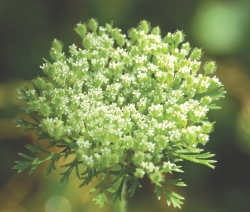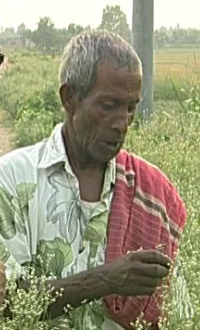FARMERS’ VOICE
The Silent Killer
Today, I'll tell you of a killer weed, a very harmful one that is spreading quite fast in the country. Especially around the Rajshahi district, the situation is extremely alarming. This is harmful, not only for farming, but the food chain, human health and also for livestock. Farmers don't care much about the weeds. Farmers feel that the plant is kind of a protection for their lands, cattle won't enter lands and that's why they don't generally cut, burn or uproot these weeds. And, they don't know what severe threat is entering their arable lands!
.................................................................................................
Shykh Seraj
 The killer weed 'Parthenium', a new threat to Bangladesh, of which I was telling you at the beginning. Among six dangerous toxic weeds, Parthenium is one. In India, 0.4 million hectares of land can't produce anything because of this killer weed. The weed reduces crop productivity by 40%. We hear many death stories, caused by this harmful weed. In recent times, the weed is spreading very fast in Bangladesh. Nobody can tell of its origin. Wherever you see Parthenium, no other plants grow near it. It grows incredibly fast. The Bangladeshi farming sector is certainly standing in front of the new predicament, called, 'Parthenium'. The killer weed 'Parthenium', a new threat to Bangladesh, of which I was telling you at the beginning. Among six dangerous toxic weeds, Parthenium is one. In India, 0.4 million hectares of land can't produce anything because of this killer weed. The weed reduces crop productivity by 40%. We hear many death stories, caused by this harmful weed. In recent times, the weed is spreading very fast in Bangladesh. Nobody can tell of its origin. Wherever you see Parthenium, no other plants grow near it. It grows incredibly fast. The Bangladeshi farming sector is certainly standing in front of the new predicament, called, 'Parthenium'.
We notice these kinds of weeds on the roads and even in forests. Scientists say, this herb entered Bangladesh a few years ago. Nature has many unknown herbs, weeds and flowering plants. There are many useful medicinal herbs/plants as well. We don't find or see many of those these days. 'Parthenium' has some real fear factors. In case of producing maize, it reduces the productivity by 30%. Apart from that, it also decreases production of paddy, chick peas, mustard, wheat, eggplants and chilies. It can be easily referred to arsenic, a dangerous threat to human health. You may add bronchitis, asthma and many other deadly diseases, which are caused by Parthenium. Even the livestock is getting affected due to this toxic weed.
People of Bangladesh know very little about this killer weed. College Teacher and founder of 'Shah Agriculture Library', Shah Jahangir Hossain found out about Parthenium's severe effects in the Rajshahi district. I had the privilege to speak with him regarding this little-known weed. He learned about Parthenium from a workshop, conducted by an Australian Professor in the Manda region. He also said that it's been two years since the weed has been growing and spreading across Bangladesh.
Meanwhile, Jahangir has taken up initiatives to uproot the weeds from the roads while informing the local administration about its dangers.
“You have also tried to uproot the killer weeds from the roads?”
“Yes, but, it's spreading very fast.”
“What are the negative effects of Parthenium?”
“Skin disease, bronchitis, mouth diseases of cattle… and souring of their milk if they eat too much of the weed.”
“That means the milk becomes toxic?”
“Certainly”, added Jahangir.
Pollination of eggplant, tomato, chilli is hampered. It also damages the pulse crops. The general people of our country barely know anything about the weed. Even the farmers don't know about the harmful effects of Parthenium.
I wanted to ask some general farmers whether they have any idea about Parthenium.
“Do you have any idea what this weed is?”
“We just know it has a smell.”
“Okay…what else?”
“It has a foul smell that induces nausea and itchiness”
I tried to make people aware by telling them to uproot the weed wherever they find it. However, I noticed the weed is no longer on the roadsides; it has entered the arable lands as well. It's a great barrier against healthy cultivation.
Parthenium originated in Mexico. But in time's it spread to the USA, Africa, West Indies, India, Pakistan, China, Nepal, Australia and then to Bangladesh. In different districts of Bangladesh, we can now locate Parthenium. In some regions the weed is locally known as, 'Nakfuli'. It's mostly found in Jessore, Faridpur, Rajshahi, Natore, Dhaka and in Mymensingh districts. The weed can shift its place quickly with the help of water and seeds. That is why new locations are being affected. In India, Parthenium is a big threat. There, it's commonly known as 'Carrot Weed'.
 In India, the Parthenium weed had spread quite enormously. In 1975, it had spread over 5,000,000 hectares which is equal to one-season arable land in Bangladesh. In 2010, Parthenium had spread over 35,000,000 hectares, which is at least fourfold to our arable land. Scientists say, Parthenium was first found in India's Maharashtra in 1956. Since then, it spread all over India. The botanists are extremely worried about this toxic plant. In India, the Parthenium weed had spread quite enormously. In 1975, it had spread over 5,000,000 hectares which is equal to one-season arable land in Bangladesh. In 2010, Parthenium had spread over 35,000,000 hectares, which is at least fourfold to our arable land. Scientists say, Parthenium was first found in India's Maharashtra in 1956. Since then, it spread all over India. The botanists are extremely worried about this toxic plant.
A Parthenium weed can give birth to around 25,000 micro seeds. One plant lives up to three to four months. In these months, it gives flowers as well as seeds three times. These micro seeds basically spread with the cowdung, mud under the wheels of cars, shoes and sandals, irrigation water and even through air.
Professor Dr. Rezaul Karim from Bangladesh Agricultural University's Agronomy Department, has conducted research on Parthenium. He gave me a more reasonable explanation on the growth and threatening expansion of the weed. He has conducted research on Parthenium with the Masters students of the Agronomy department. One of the researches included the 'Allelopathic Effect' of parthenium over different crops, specially how it reduces germination and growth. Dr. Karim says that the weed spreads like 'wildfire', as it burns the forest in a flash. So, you can guess how fast it may spread.
“Two years ago, I went to Sirajganj and found very few Parthenium weeds. A month back, I went there again and found so many of them”, said Dr. Karim.
“It's even next to the houses and people are still unaware of its very harmful effects. They're probably touching it, inhaling it without knowledge”, added Dr. Karim.
“They don't have any idea about the toxicity of the weed. It's spreading really fast. There will be a time when spreading awareness will stop working”, the worried professor stressed in this manner.
Parthenium decreases growth of grass as well and the cattle feed severely. This toxic weed is very dangerous for human and animal health. If people go near the weed, there's a probability of them being affected with asthma and skin disease. And, there are many other severe diseases which too are caused by the killer weed. The most heartbreaking news is in India, so far, at least 12 people died due to the toxicity of Parthenium.
Research Center for Weed Science, situated in India's Madhya Pradesh at Jabalpur conducted research on Parthenium for 20 years and they are prescribing some key factors. While uprooting the weed, one has to wear gloves. No one should just cut it down for permanent destruction. A chemical for weed controle may be used.
The bio-controles are always environment-friendly to wipe out Parthenium. In this respect, the Mexican leaf-eating beetle 'Zygograrama Bicolorata' can be used for a better result, stressed the experienced scientists.
Scientists have clearly mentioned that there is no weed more dangerous than Parthenium. Regarding the issue of food security, Parthenium is a silent killer. It is also a massive threat against public health, livestock, the farming sector and the environment. If we don't take effective measure to wipe out the killer weed right away, we would never be able to tackle an even bigger disaster in future.
We expect farming related public and private organizations, research and extension departments will take immediate initiatives to make the general people aware and definitely the farmers about the killer weed, Parthenium before it's too late.

Copyright
(R) thedailystar.net 2012 |

 T
T In India, the Parthenium weed had spread quite enormously. In 1975, it had spread over 5,000,000 hectares which is equal to one-season arable land in Bangladesh. In 2010, Parthenium had spread over 35,000,000 hectares, which is at least fourfold to our arable land. Scientists say, Parthenium was first found in India's Maharashtra in 1956. Since then, it spread all over India. The botanists are extremely worried about this toxic plant.
In India, the Parthenium weed had spread quite enormously. In 1975, it had spread over 5,000,000 hectares which is equal to one-season arable land in Bangladesh. In 2010, Parthenium had spread over 35,000,000 hectares, which is at least fourfold to our arable land. Scientists say, Parthenium was first found in India's Maharashtra in 1956. Since then, it spread all over India. The botanists are extremely worried about this toxic plant. 